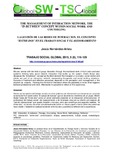Mostrar el registro sencillo del ítem
The management of interaction network. The 'in-between' concept within social work and counseling
| dc.creator | Hernández Aristu, Jesús | es_ES |
| dc.date.accessioned | 2019-05-27T11:47:07Z | |
| dc.date.available | 2019-05-27T11:47:07Z | |
| dc.date.issued | 2015 | |
| dc.identifier.issn | 2013-6757 | |
| dc.identifier.uri | https://hdl.handle.net/2454/33139 | |
| dc.description.abstract | Dentro de la tradición del trabajo social y en otros sistemas de intervención con personas es conocida la teoria de Kurt Lewin sobre "el campo de fuerzas" que se da entre los miembros de un grupo. Martin Buber habla del "Entre-dos" como un tercer elemento presente en la interacción entre personas. El profesional del trabajo social, del asesoramiento o de la terapia crea con su cliente una especie de "red de interacciones" que queda invisible a los ojos, pero que constituye una segunda realidad, "el Entre-dos". La técnica de pintar simultáneamente sobre un mismo papel o lienzo entre dos personas hace visible y hablable la realidad existente entre los dos y posibilita la reflexión de la experiencia. | es_ES |
| dc.description.abstract | We are familiar with the field of group interaction through the traditional work of Kurt Lewin and also systemic thinking talks about network interaction that builds up the system. Martin Buber also discusses the “in-between” concept as the third element.The therapist or counselor, social worker and clients are part of an interaction network, representing therapeutic and social working situations. Success in treatment and reflective processes, depends on the perception and management of the situation by experts. Painting the moment of interaction offers the possibility to know what happens between professional and client. Afterwards it is possible to reflect on this experience. | en |
| dc.format.extent | 14 p. | |
| dc.format.mimetype | application/pdf | en |
| dc.language.iso | eng | en |
| dc.publisher | Universidad de Granada | es_ES |
| dc.relation.ispartof | Trabajo Social Global 2015, 5 (8), 116-129 | es_ES |
| dc.rights | Creative Commons Reconocimiento-NoComercial-CompartirIgual 4.0 Internacional (CC BY-NC-SA 4.0) | en |
| dc.rights.uri | https://creativecommons.org/licenses/by-nc-sa/4.0/deed.es_ES/ | |
| dc.subject | Interacción | es_ES |
| dc.subject | Entre-dos | es_ES |
| dc.subject | Comunicación | es_ES |
| dc.subject | Terapia | es_ES |
| dc.subject | Asesoramiento | es_ES |
| dc.subject | Trabajo social | es_ES |
| dc.subject | Metodología | es_ES |
| dc.subject | Reflexión | es_ES |
| dc.subject | Interaction | en |
| dc.subject | In-between | en |
| dc.subject | Therapy | en |
| dc.subject | Counseling | en |
| dc.subject | Social work | en |
| dc.subject | Methodology | en |
| dc.subject | Reflexion | en |
| dc.title | The management of interaction network. The 'in-between' concept within social work and counseling | en |
| dc.type | info:eu-repo/semantics/article | en |
| dc.type | Artículo / Artikulua | es |
| dc.contributor.department | Trabajo Social | es_ES |
| dc.contributor.department | Gizarte Lana | eu |
| dc.rights.accessRights | info:eu-repo/semantics/openAccess | en |
| dc.rights.accessRights | Acceso abierto / Sarbide irekia | es |
| dc.type.version | info:eu-repo/semantics/publishedVersion | en |
| dc.type.version | Versión publicada / Argitaratu den bertsioa | es |



